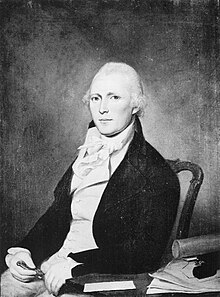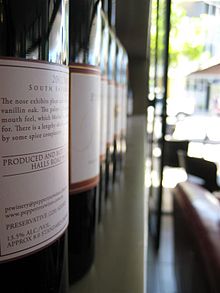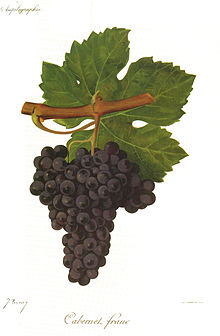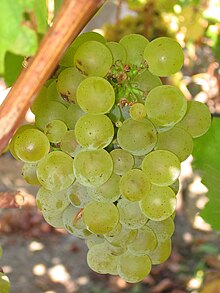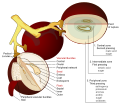Portal:Wine
The Wine Portal


Wine is an alcoholic beverage made from fermentation of grape juice. The natural chemical balance of grapes is such that they can ferment without the addition of sugars, acids, enzymes, or other nutrients. Although fruits other than grapes can also be fermented, the resultant wines are normally named after the fruit from which they are produced (for example, apple wine) and are known as fruit wine (or country wine). Others, such as barley wine and rice wine (e.g. sake), are made from starch-based materials and resemble beer more than wine; ginger wine is fortified with brandy. In these cases, the use of the term "wine" is a reference to the higher alcohol content, rather than the production process. The commercial use of the word "wine" (and its equivalent in other languages) is protected by law in many jurisdictions. Wine is produced by fermenting crushed grapes using various types of yeast which consume the sugars found in the grapes and convert them into alcohol. Various varieties of grapes and strains of yeasts are used depending on the types of wine produced.
Wine stems from an extended and rich history dating back about 8,000 years and is thought to have originated in present-day Georgia or Iran. Wine is thought to have appeared in Europe about 6,500 years ago in present-day Bulgaria and Greece and was very common in ancient Greece and Rome; the Greek god Dionysos, and his Roman counterpart Liber represented wine. Wine continues to play a role in religious ceremonies, such as Kiddush in Judaism and the Eucharist in Christianity. (Full article...)
Selected articles -
Did you know (auto-generated) -

- ... that the Anglo-Saxons may have used a mixture of garlic, another Allium, wine, and bovine bile as an eye medicine?
- ... that while Joseph Longworth thought that he would be remembered only as "the son of his father and the father of his son", there is today a wing of the Cincinnati Art Museum named for him?
- ... that illustrator Abigail Larson once designed a wine-bottle label for the Edgar Allan Poe Museum?
- ... that the magazine Acoustic Guitar said that Dan Erlewine "might be the most famous guitar repairperson on earth"?
- ... that Julia Marden was the first known person to create a Wampanoag twined turkey-feather mantle since European contact 400 years earlier?
- ... that the Louis M. Martini Winery began selling wine on December 5, 1933 – the day on which Prohibition in the United States was repealed?
- ... that sociologist Richard Twine has developed the concept of the "vegan killjoy" who challenges anthropocentrism by their mere presence?
- ... that the wine cellar of New York City's Barclay Hotel is on the second floor?
Selected quote
| “ | Go, eat your food with gladness, and drink your wine with a joyful heart, for it is now that God favours what you do. | ” |
| — King James Bible Ecclesiastes 9:7 |
Related portals
Selected winery
Dominus Estate, formerly Napanook Vineyards, is a California wine estate producing Bordeaux style blends, owned by Christian Moueix. The winery is located in Yountville within the Napa Valley AVA. George C. Yount, the founder of Yountville, planted in 1836 the first vines of the valley on the location of Napanook vineyard. In 1850 the property was bought by Charles Hopper, and owners since include Hugh La Rue, a pioneer in the use of rootstock and John Daniel Jr., the owner of Inglenook Winery who bought the estate in 1946.
Following Daniel's death in 1970, Napanook passed to his daughters Robin Lail and Marcia Smith who in 1982 began a partnership with Christian Moueix, acting on a recommendation by Robert Mondavi to establish production in Napa Valley. Moueix, also in charge of production at Château Pétrus and president of Établissements Jean-Pierre Moueix, became the sole owner of Dominus Estate when Lail and Smith sold their shares in 1995. Napanook, the estate's second wine, was first released in 1996. (Full article...)
General images -
Selected picture
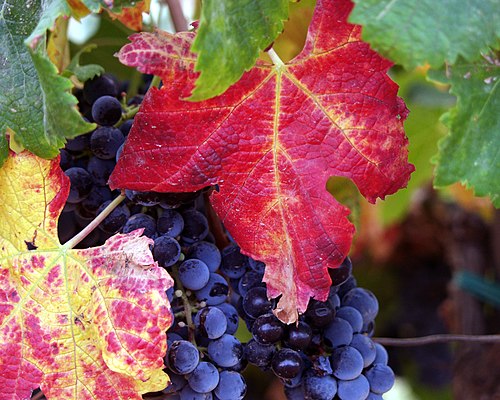
Topics
List articles

Categories
Related WikiProjects
| Parent project: WikiProject Food and Drink | |
| Child projects: | Task forces: (All inactive) |
|
|
| Related projects: | |
Things you can do
|
|
Here are some tasks you can do for WikiProject Wine:
|
Associated Wikimedia
The following Wikimedia Foundation sister projects provide more on this subject:
-
Commons
Free media repository -
Wikibooks
Free textbooks and manuals -
Wikidata
Free knowledge base -
Wikinews
Free-content news -
Wikiquote
Collection of quotations -
Wikisource
Free-content library -
Wikispecies
Directory of species -
Wikiversity
Free learning tools -
Wikivoyage
Free travel guide -
Wiktionary
Dictionary and thesaurus

![Image 1 Grenache noir in Viala & Vermorel Grenache (/ɡrəˈnæʃ/; French pronunciation: [ɡʁənaʃ] ⓘ) or Garnacha (Spanish pronunciation: [ɡaɾˈnatʃa]) is one of the most widely planted red wine grape varieties in the world. It ripens late, so it needs hot, dry conditions such as those found in Spain, where the grape is believed to have originated. It is also grown in the Italian island of Sardinia, the south of France, Australia, and California's Monterey AVA, Paso Robles, Santa Barbara County and San Joaquin Valley. It is generally spicy, berry-flavored and soft on the palate and produces wine with a relatively high alcohol content, but it needs careful control of yields for best results. Characteristic flavor profiles on Grenache include red fruit flavors (raspberry and strawberry) with a subtle, white pepper spice note. Grenache wines are highly prone to oxidation, with even young examples having the potential to show browning (or "bricking") coloration that can be noticed around the rim when evaluating the wine at an angle in the glass. As Grenache ages the wines tend to take on more leather and tar flavors. Wines made from Grenache tend to lack acid, tannin and color, and it is often blended with other varieties such as Syrah, Carignan, Tempranillo, and Cinsaut. (Full article...)](http://upload.wikimedia.org/wikipedia/en/d/d2/Blank.png)


